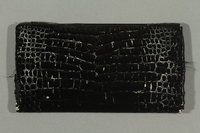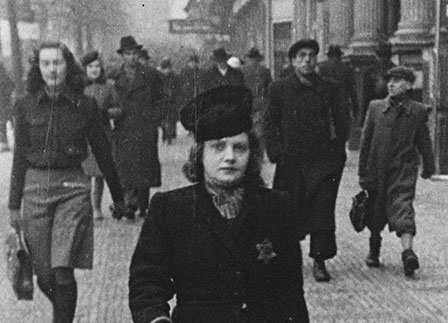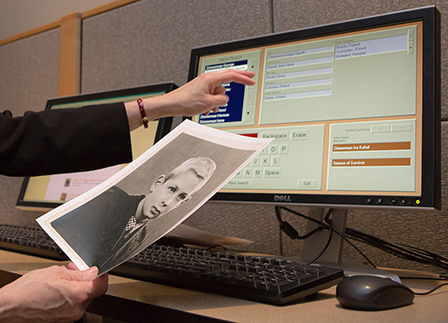Overview
- Description
- The Marcus family papers include correspondence, a family tree, and photographs relating to Erich and Thea Marcus and their children, Harry and Lilo, originally from Prenzlau, Germany. The family fled to Cuba before immigrating to the United States circa 1941. Correspondence largely includes personal correspondence to Erich from friends and family, including Susie and Lotte, as well as letters from organizations including the Congress Refugee House and New York Associate for Jewish Children. Also included is a family tree and photographs of Erich, Thea, and their family.
- Date
-
inclusive:
circa 1930-1998
bulk: 1939-1942
- Credit Line
- United States Holocaust Memorial Museum Collection, Gift of Deborah Marcus Masters
- Collection Creator
- Erich Marcus
- Biography
-
Erich Marcus (1889-1972) was born in Prenzlau, Germany, to Emil (1859-1940) and Margarethe (1867-1940) Zippert Marcus. Erich had a sister, Charlotte (1890-1968) and the family owned a houseware factory. Erich served in the German cavalry during World War I. After the war, he married Phyllis Lewek (also known as Theophila, Theo, 1892-1981) in the mid-1920s and had two children, Heinrich (1929-2005, later Harry) and Lilo (also known as Lillian or Lieselotte, 1934-1993). Charlotte married Heinrich Joseph (1889-1929) and had two children, Walther (b.1920-?) and Susanne (b. 1924-?). The Marcus family had been living in Germany for hundreds of years. Emil was president of the Prenzlau synagogue and the family was secularized into German society but was also active in the local Jewish community.
On January 30, 1933, Adolf Hitler was appointed Chancellor of Germany and anti-Jewish decrees were passed that restricted every aspect of Jewish life. Heinrich was no longer allowed to go to class because Jews had been barred from attending public school, and the family’s business was forcibly taken by non-Jewish Germans. In 1937, the Nazi authorities caught nine year old Heinrich playing in a playground that Jews had been barred from and shot him. The bullet struck his head, although it did not seriously injure him, he would carry the scar above his eye for the rest of his life. In 1939, Erich was arrested by the German authorities. He was only released when his wife, Phyllis, bribed the police chief’s mother with the cash savings the family had buried in their back yard. Even then, he was only released on the condition that he emigrate from Germany. Later that year, with the help of their neighbor Bret Schneider, Erich, Phyllis, Heinrich and Lilo were able to escape to Cuba. The family stayed in Cuba until January 10, 1941, when they boarded the SS Imperial and arrived in New York City on January 14.
Erich offered to pay for his sister Charlotte’s emigration, but she refused to go. Charlotte was able to destroy all her identification documents and then moved to Danzig, where no one knew her and she could safely live under a false name. She got a job working as a maid for a Gestapo officer, survived the war and later moved to England. Charlotte’s children, Walther and Susanne, both escaped to England. Susanne remained in England throughout the duration of the war. Walther, however, was interned as a German enemy alien after Britain declared war on Germany. He was deported to Canada and held in Camp 23 (also called Camp Q) in Monteith, Ontario, and Camp 41 (also called Camp I) in Ile-aux-Noix, Quebec. After he was released, Walther returned to England, joined the British Army, and served in Europe. Many family members who were not able to escape Germany were killed in Auschwitz-Birkenau killing center in German occupied Poland. Erich’s parents, Emil and Margarethe, were not able to leave Germany and chose to end their own lives rather than allow the Nazis to deport them to the killing centers in the East.
Upon their arrival in the United States, Erich and Heinrich Americanized their names to Eric and Harry. Eric and Phyllis remained in New York City, and Eric was able to get a job with Lynch and Gildener Inc. After arriving in the U.S., Harry and Lilo had to spend time away from their parents until they became settled. During the summer in 1942, Harry went to Cold Springs Surprise Lake Camp and Camp Wakitan Jewish sleep away camps, and used the experience to help his adjustment to American culture. Lilo lived with family friends and also stayed at the Pleasantville Cottage School, which was operated by the Women’s Division American Jewish Congress and Jewish Institute of Religion. These two organizations transformed three townhouses into refugee houses, which furnished food, temporary shelter, educational programs and other necessities to thousands of Jews who reached the United States.
After World War II ended, Harry served as a cook in the US Army during the Korean War. In 1957, he married Luba Berlin in New York City. Before they married, both Harry and Luba lived in Cuba. Luba’s family fled to Cuba in the 1920s to escape pogroms in Ukraine and then moved to the United States in 1940. After moving to New York, Harry earned a graduate degree in social work and became a social worker in Harlem, assisting unwed mothers with social services and he was active in the Civil Rights Movement.
Physical Details
- Genre/Form
- Correspondence. Photographs.
- Extent
-
1 box
- System of Arrangement
- The Marcus family papers are arranged in one box:
Folder 1: Correspondence, 1939-1940
Folder 2-4: Correspondence, 1941
Folder 5: Correspondence, 1942, 1949
Folder 6: Family tree, 1998
Folder 7: Photographs, circa 1930-1950
Rights & Restrictions
- Conditions on Access
- There are no known restrictions on access to this material.
- Conditions on Use
- Material(s) in this collection may be protected by copyright and/or related rights. You do not require further permission from the Museum to use this material. The user is solely responsible for making a determination as to if and how the material may be used.
Keywords & Subjects
- Geographic Name
- United States--Emigration and immigration. Cuba--Emigration and immigration. Prenzlau (Germany)
- Personal Name
- Marcus, Erich
Administrative Notes
- Holder of Originals
-
United States Holocaust Memorial Museum
- Legal Status
- Permanent Collection
- Provenance
- Donated to the United States Holocaust Memorial Museum in 2018 by Deborah Marcus Masters, daughter of Harry and Luba Marcus.
- Record last modified:
- 2023-06-16 13:12:47
- This page:
- http://collections.ushmm.org/search/catalog/irn622327
Download & Licensing
- In Copyright - Use Permitted
- Terms of Use
- This record is not digitized and cannot be downloaded online.
In-Person Research
- Not Available for Research: Out for Digitization
- Plan a Research Visit
-
Request in Shapell Center Reading Room
Bowie, MD
Contact Us
Also in Harry and Luba Marcus family collection
The collection consists of a wallet, documents, correspondence, and photographs relating to the experiences of the Marcus family in Prenzlau, Germany, before and during the Holocaust, and in Cuba and the United States during and after the Holocaust.
Date: approximately 1941

Leather bi-fold wallet with two photographs glued inside owned by a German Jewish refugee
Object
Leather wallet, with two photos adhered inside, used by Erich Marcus. The photos are of Erich’s parents, Emil and Margarethe. Both parents were unable to escape Germany during the Holocaust and chose to end their own lives in 1940, rather than allow the Nazis to deport them to the killing centers in the East. Erich’s family owned a successful houseware factory in Prenzlau, Germany. Erich lived with his wife Phyllis and two children, Heinrich and Lilo. Erich’s parents, his sister, and her two children lived in Prenzlau as well. After Adolf Hitler became Chancellor of Germany, the Marcus family’s business was taken from them and their children were no longer allowed to attend public school. In 1937, the Nazi authorities caught nine-year-old Heinrich playing in a playground that Jews had been barred from and shot him. The bullet struck his head, but did not seriously injure him. In 1939, Erich was arrested and was only released after he guaranteed that he would pay a large bribe, and leave the country. Later that year Erich and his family escaped to Cuba, and then immigrated to the United States in 1941. Erich’s sister, Charlotte, hid under a false identity in Danzig for the duration of the war. Her two children, Walther and Susanne, escaped to England and were joined by Charlotte after the conclusion of the war. Many extended family members who could not escape were killed in Auschwitz-Birkenau killing center in German occupied Poland.



